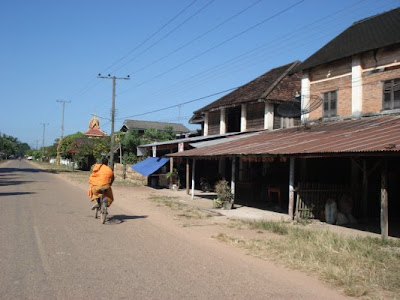Elephant owners in Xayaboury province have been relying on the timber industry for many decades; they earn a living by taking their elephants to carry timber out of forests in areas that trucks cannot access.
 |
The festival's elephant parade. |
But since the government announced a ban on logging activities throughout the country, hundreds of elephants and their owners have had to give up their jobs. Many have had to accept that they will have to sell their giant animals to neighbouring countries and change occupations.
The government has recognised this problem and is looking for ways to help; the annual Elephant Festival is one such way.
This year, the Elephant Festival will be held in Paklai district, a mountainous town located along the Mekong . The district is home to many elephants due to the booming logging business that made use of the animals for several decades.
The first Elephant Festival was initiated and organised by the French-run ElefantAsia in 2007, and took place in Hongsa district in Xayaboury province.
Speaking at a press conference last week, governor of Xayaboury province Dr Lien Thikeo said the elephant festival had become an annual tradition, and that this year's event would be bigger and better.
It will take place from February 15 to 17; according to the official schedule from the Lao National Tourism Administration (LNTA), there will be several activities including competitions between people and elephants, an elephant “beauty contest”, boat racing and a rocket-making competition.
In 2002, the National Tourism Administration in cooperation with ElefantAsia organised a long elephant caravan from southern province of Champassak to Luang Prabang province. The 1,300 km caravan began in February to coincide with the Vat Phou Festival and ended at Lao New Year. Several hundred elephants took part in the event.
The main objective was to encourage Lao people to protect the endangered giant animals as well as to promote Lao tourism.
Dr Lien said elephants were animals with an important connection to the livelihoods of local people. During the war for national liberation, elephants were used to transport weapons and military supplies for the revolutionary armed forces. They also helped local people to carry timber from forests to villages to build houses.
“Elephants are animals with great virtue, but unfortunately we have had to witness a decrease in their numbers,” he said.
According to the LNTA, there are only 560 domestic elephants left in Laos , mostly in Xayaboury province. It is possible that this decline could lead to the eventual disappearance of these giant animals in this country, once known as the “land of a million elephants”.
According to ElefantAsia, there are more than 2,000 wild and domestic elephants in Laos , only 200 remaining in Vietnam and 150 in Cambodia . In Asia , there are thought to be about 15,000 domestic and 35,000 wild elephants.
The decline in the elephant population is due to several factors, the main one being that their natural habit has been destroyed by logging activities and, as haulers of logs, domestic elephants have to work hard, which gives them little chance to breed, according to the LNTA.
The LNTA also points out that the disappearance of the elephants would lead to the disappearance of some traditional customs and lifestyles; for example, Xayaboury people like to hold baci ceremonies for their elephants each year in recognition of their virtues.
This ceremony is unique to certain parts of Laos , and the fact that locals keep elephants is good for the tourist industry, as visitors are fascinated by traditional practices that no longer exist in developed countries.
Dr Lien maintained that the elephant festival would not only boost tourism, but would also serve to integrate elephants into the industry itself, possibly the only way to sustain a population now that they are “out of work”.
He added that by protecting the elephants, long-standing traditional values would also be preserved and could be incorporated into to urist activities.
Dr Lien called on local and international tourists to attend the elephant festival, saying he was certain it would not disappoint.
How to get Paklai There are basically four ways.
The second way is to travel to Hinheub district in Vientiane province, turn left to Feuang district and continue on a long dirt road to Sanakham and cross the Mekong on a ferry to Paklai.
The first is to travel by boat from Kaoliew in Vientiane , taking either a slow boat or a speedboat.
The third way is to travel to Luang P rabang province, then to Xayaboury district, the provincial town of Xayaboury , and then on to Paklai district.
The fourth way is to cross the Vientiane-Nong Khai Friendship Bridge to Thailand , and then go to Thalee district in Loei province and cross into Khaenthao district, Xayaboury province, before arriving in Paklai.
Where to stay There are 14 guesthouses in Paklai, with accommodation for only 300 visitors. Howev er, district authorities have arranged home-stay services – ask about these at the Information Centre. Camping places are also available.
By Ekaphone Phouthonesy (Latest Update Febuary 11, 2008)










